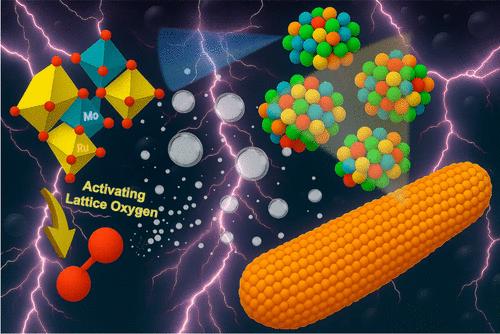中熵尖晶石氧化物中点阵氧活化的水氧化
IF 18.2
1区 材料科学
Q1 CHEMISTRY, PHYSICAL
引用次数: 0
摘要
高效析氧反应催化剂的开发需要在机理理解和材料设计两方面取得进展。晶格氧氧化机制(LOM)通常比吸收演化机制(AEM)具有更低的热力学势垒,但控制从AEM到LOM的OER途径仍然具有挑战性。在这里,我们通过战略性八面体工程证明了尖晶石结构的CoFeMoRu中熵氧化物(CoFeMoRuMEO)催化剂的高效晶格氧活化。Mo的引入增加了Co位点的电子密度,从而减弱了OH的吸附,抑制了通过AEM途径生成CoOOH。同时,压缩的RuO6八面体产生缩短的Ru-O键,增强了Ru-O共价,促进了关键的O-O耦合步骤。结果表明,comfemorumeo催化剂在10 mA cm-2下获得了168 mV的过电位,为中高熵OER催化剂树立了新的标杆。我们的工作为OER机制的转变和性能优化提供了有价值的见解。本文章由计算机程序翻译,如有差异,请以英文原文为准。

Water Oxidation in Medium-Entropy Spinel Oxides via Lattice Oxygen Activation
The development of efficient oxygen evolution reaction (OER) catalysts requires advancements in both the mechanism understanding and material design. The lattice oxygen oxidation mechanism (LOM) typically has a lower thermodynamic barrier than the absorbate evolution mechanism (AEM), yet controlling the OER pathway from the AEM to the LOM remains challenging. Here, we demonstrate efficient lattice oxygen activation in a spinel-structured CoFeMoRu medium-entropy oxide (CoFeMoRuMEO) catalyst through strategic octahedral engineering. The introduction of Mo increases the electron density at the Co sites, thereby weakening OH adsorption and suppressing CoOOH formation via the AEM pathway. Meanwhile, compressed RuO6 octahedra create shortened Ru–O bonds, enhancing Ru–O covalency and facilitating the critical O–O coupling step. As a result, the CoFeMoRuMEO catalyst achieves a remarkable overpotential of 168 mV at 10 mA cm–2, setting a new benchmark for medium-to-high-entropy OER catalysts. Our work provides valuable insights into the transformation of the OER mechanism and performance optimization.
求助全文
通过发布文献求助,成功后即可免费获取论文全文。
去求助
来源期刊

ACS Energy Letters
Energy-Renewable Energy, Sustainability and the Environment
CiteScore
31.20
自引率
5.00%
发文量
469
审稿时长
1 months
期刊介绍:
ACS Energy Letters is a monthly journal that publishes papers reporting new scientific advances in energy research. The journal focuses on topics that are of interest to scientists working in the fundamental and applied sciences. Rapid publication is a central criterion for acceptance, and the journal is known for its quick publication times, with an average of 4-6 weeks from submission to web publication in As Soon As Publishable format.
ACS Energy Letters is ranked as the number one journal in the Web of Science Electrochemistry category. It also ranks within the top 10 journals for Physical Chemistry, Energy & Fuels, and Nanoscience & Nanotechnology.
The journal offers several types of articles, including Letters, Energy Express, Perspectives, Reviews, Editorials, Viewpoints and Energy Focus. Additionally, authors have the option to submit videos that summarize or support the information presented in a Perspective or Review article, which can be highlighted on the journal's website. ACS Energy Letters is abstracted and indexed in Chemical Abstracts Service/SciFinder, EBSCO-summon, PubMed, Web of Science, Scopus and Portico.
 求助内容:
求助内容: 应助结果提醒方式:
应助结果提醒方式:


